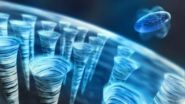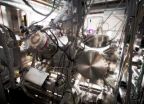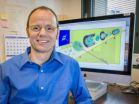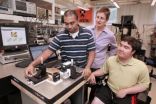(Press-News.org) An experiment at the Department of Energy's SLAC National Accelerator Laboratory revealed a well-organized 3-D grid of quantum "tornadoes" inside microscopic droplets of supercooled liquid helium – the first time this formation has been seen at such a tiny scale.
The findings by an international research team provide new insight on the strange nanoscale traits of a so-called "superfluid" state of liquid helium. When chilled to extremes, liquid helium behaves according to the rules of quantum mechanics that apply to matter at the smallest scales and defy the laws of classical physics. This superfluid state is one of just a few examples of quantum behavior on a large scale that makes the behavior easier to see and study.
The results, detailed in the Aug. 22 issue of Science, could help shed light on similar quantum states, such as those in superconducting materials that conduct electricity with 100 percent efficiency or the strange collectives of particles, dubbed Bose-Einstein condensates, which act as a single unit.
"What we found in this experiment was really surprising. We did not expect the beauty and clarity of the results," said Christoph Bostedt, a co-leader of the experiment and a senior scientist at SLAC's Linac Coherent Light Source (LCLS), the DOE Office of Science User Facility where the experiment was conducted.
"We were able to see a manifestation of the quantum world on a macroscopic scale," said Ken Ferguson, a PhD student from Stanford University working at LCLS.
While tiny tornadoes had been seen before in chilled helium, they hadn't been seen in such tiny droplets, where they were packed 100,000 times more densely than in any previous experiment on superfluids, Ferguson said.
Studying the Quantum Traits of a Superfluid
Helium can be cooled to the point where it becomes a frictionless substance that remains liquid well below the freezing point of most fluids. The light, weakly attracting atoms have an endless wobble – a quantum state of perpetual motion that prevents them from freezing. The unique properties of superfluid helium, which have been the subject of several Nobel prizes, allow it to coat and climb the sides of a container, and to seep through molecule-wide holes that would have held in the same liquid at higher temperatures.
In the LCLS experiment, researchers jetted a thin stream of helium droplets, like a nanoscale string of pearls, into a vacuum. Each droplet acquired a spin as it flew out of the jet, rotating up to 2 million turns per second, and cooled to a temperature colder than outer space. The X-ray laser took snapshots of individual droplets, revealing dozens of tiny twisters, called "quantum vortices," with swirling cores that are the width of an atom.
The fast rotation of the chilled helium nanodroplets caused a regularly spaced, dense 3-D pattern of vortices to form. This exotic formation, which resembles the ordered structure of a solid crystal and provides proof of the droplets' quantum state, is far different than the lone whirlpool that would form in a regular liquid, such as briskly stirred cup of coffee.
More Surprises in Store
Researchers also discovered surprising shapes in some superfluid droplets. In a normal liquid, droplets can form peanut shapes when rotated swiftly, but the superfluid droplets took a very different form. About 1 percent of them formed unexpected wheel-like shapes and reached rotation speeds never before observed for their classical counterparts.
Oliver Gessner, a senior scientist at Lawrence Berkeley Laboratory and a co-leader in the experiment, said, "Now that we have shown that we can detect and characterize quantum rotation in helium nanodroplets, it will be important to understand its origin and, ultimately, to try to control it."
Andrey Vilesov of the University of Southern California, the third experiment co-leader, added, "The experiment has exceeded our best expectations. Attaining proof of the vortices, their configurations in the droplets and the shapes of the rotating droplets was only possible with LCLS imaging."
He said further analysis of the LCLS data should yield more detailed information on the shape and arrangement of the vortices: "There will definitely be more surprises to come."
INFORMATION:
Other research collaborators were from the Stanford PULSE Institute; University of California, Berkeley; the Max Planck Society; Center for Free-Electron Laser Science at DESY; PNSensor GmbH; Chinese University of Hong Kong; and Kansas State University. This work was supported by the National Science Foundation, the U.S. Department of Energy Office of Science (Basic Energy Sciences) and the Max Planck Society.
SLAC is a multi-program laboratory exploring frontier questions in photon science, astrophysics, particle physics and accelerator research. Located in Menlo Park, California, SLAC is operated by Stanford University for the U.S. Department of Energy Office of Science. To learn more, please visit http://www.slac.stanford.edu.
SLAC National Accelerator Laboratory is supported by the Office of Science of the U.S. Department of Energy. The Office of Science is the single largest supporter of basic research in the physical sciences in the United States, and is working to address some of the most pressing challenges of our time. For more information, please visit science.energy.gov.
X-ray laser probes tiny quantum tornadoes in superfluid droplets
SLAC experiment reveals mysterious order in liquid helium
2014-08-21
ELSE PRESS RELEASES FROM THIS DATE:
Researchers map quantum vortices inside superfluid helium nanodroplets
2014-08-21
Scientists have, for the first time, characterized so-called quantum vortices that swirl within tiny droplets of liquid helium. The research, led by scientists at the U.S. Department of Energy's Lawrence Berkeley National Laboratory (Berkeley Lab), the University of Southern California, and SLAC National Accelerator Laboratory, confirms that helium nanodroplets are in fact the smallest possible superfluidic objects and opens new avenues to study quantum rotation.
"The observation of quantum vortices is one of the most clear and unique demonstrations of the quantum properties ...
Sunlight, not microbes, key to CO2 in Arctic
2014-08-21
CORVALLIS, Ore. – The vast reservoir of carbon stored in Arctic permafrost is gradually being converted to carbon dioxide (CO2) after entering the freshwater system in a process thought to be controlled largely by microbial activity.
However, a new study – funded by the National Science Foundation and published this week in the journal Science – concludes that sunlight and not bacteria is the key to triggering the production of CO2 from material released by Arctic soils.
The finding is particularly important, scientists say, because climate change could affect when ...
A novel 'man and machine' decision support system makes malaria diagnostics more effective
2014-08-21
A Finnish-Swedish research group at the Institute for Molecular Medicine Finland (FIMM), University of Helsinki, and Karolinska institutet, Stockholm, has developed a novel "man and machine" decision support system for diagnosing malaria infection. This innovative diagnostic aid was described in PLOS One scientific journal today, 21 August. The method is based on computer vision algorithms similar to those used in facial recognition systems combined with visualization of only the diagnostically most relevant areas. Tablet computers can be utilized in viewing the images.
In ...
Scientists observe quantum vortices in cold helium droplets
2014-08-21
An international research team including DESY scientists has observed tiny quantum vortices in cold droplets of liquid helium. The team reports in the journal Science that the exotic vortices arrange themselves as densely packed lattices inside the nanodroplets. It is the first time that the quantum vortices, which have already been observed in larger samples of what is known as superfluid helium, have been detected in nanodroplets. "The experiment has exceeded our best expectations," says Andrey Vilesov of the University of Southern California, one of the experiment's ...
Hot-spring bacteria reveal ability to use far-red light for photosynthesis
2014-08-21
Bacteria growing in near darkness use a previously unknown process for harvesting energy and producing oxygen from sunlight, a research team led by a Penn State University scientist has discovered. The discovery lays the foundation for further research aimed at improving plant growth, harvesting energy from the Sun, and understanding dense blooms like those now occurring on Lake Erie and other lakes worldwide. A paper describing the discovery will be published in the Science Express edition of the journal Science on 21 August 2014.
"We have shown that some cyanobacteria, ...
New DNA test for diagnosing diseases linked to childhood blindness
2014-08-21
SAN FRANCISCO – Aug. 21, 2014 – Researchers in the United Kingdom have demonstrated that advanced DNA testing for congenital cataracts can quickly and accurately diagnose a number of rare diseases marked by childhood blindness, according to a study published online today in Ophthalmology, the journal of the American Academy of Ophthalmology. Using a single test, doctors were able to tailor care specifically to a child's condition based on their mutations reducing the time and money spent on diagnosis and enabling earlier treatment and genetic counseling.
Each year, ...
USC Eye Institute study shows Native American ancestry a risk factor for eye disease
2014-08-21
LOS ANGELES — New research led by the University of Southern California (USC) Eye Institute, part of Keck Medicine of USC, shows for the first time that Native American ancestry is a significant risk factor for vision-threatening diabetic retinopathy among Latinos with Type 2 diabetes. Diabetic retinopathy is the leading cause of blindness in working-age adults in the United States, affecting more than 4 million Americans age 40 and older.
The research was published online today in Investigative Ophthalmology & Visual Science, the peer-reviewed academic journal of The ...
Novel recycling methods: The fluorescent fingerprint of plastics
2014-08-21
Researchers at Ludwig-Maximilians-Universitaet (LMU) in Munich have developed a new process which will greatly simplify the process of sorting plastics in recycling plants. The method enables automated identification of polymers, facilitating rapid separation of plastics for re-use.
A team of researchers led by Professor Heinz Langhals of LMU's Department of Chemistry has taken a significant step which promises to markedly expedite the recycling of plastic waste. They have developed a technique which provides for automated recognition of their polymer constituents, thus ...
CHEST releases new expert guidance in care of the critically ill and injured
2014-08-21
The American College of Chest Physicians (CHEST) announces the immediate release of Care of the Critically Ill and Injured During Pandemics and Disasters: CHEST Consensus Statement today in the Online First section of the journal CHEST while the global health-care community cares for patients with the Ebola virus. The consensus statement aims to guide ethical decision-making, coordination of care, resource conservation, and research in crises. The statement was developed by over 100 clinicians and experts representing a broad variety and scope of clinical fields from more ...
Laser device may end pin pricks, improve quality of life for diabetics
2014-08-21
Princeton University researchers have developed a way to use a laser to measure people's blood sugar, and, with more work to shrink the laser system to a portable size, the technique could allow diabetics to check their condition without pricking themselves to draw blood.
"We are working hard to turn engineering solutions into useful tools for people to use in their daily lives," said Claire Gmachl, the Eugene Higgins Professor of Electrical Engineering and the project's senior researcher. "With this work we hope to improve the lives of many diabetes sufferers who depend ...
LAST 30 PRESS RELEASES:
University of Oklahoma researcher awarded funding to pursue AI-powered material design
Exploring how the visual system recovers following injury
Support for parents with infants at pediatric check-ups leads to better reading and math skills in elementary school
Kids’ behavioral health is a growing share of family health costs
Day & night: Cancer disrupts the brain’s natural rhythm
COVID-19 vaccination significantly reduces risk to pregnant women and baby
The role of vaccination in maternal and perinatal outcomes associated with COVID-19 in pregnancy
Mayo Clinic smartwatch system helps parents shorten and defuse children's severe tantrums early
Behavioral health spending spikes to 40% of all children’s health expenditures, nearly doubling in a decade
Digital cognitive behavioral treatment for generalized anxiety disorder
Expenditures for pediatric behavioral health care over time and estimated family financial burden
Air conditioning in nursing homes and mortality during extreme heat
The Alps to lose a record number of glaciers in the next decade
What makes a good proton conductor?
New science reporting guide published for journalists in Bulgaria
New international study reveals major survival gaps among children with cancer
New science reporting guide published for journalists in Turkey
Scientists develop a smarter mRNA therapy that knows which cells to target
Neuroanatomy-informed brain–machine hybrid intelligence for robust acoustic target detection
Eight SwRI hydrogen projects funded by ENERGYWERX
The Lundquist Institute and its start-up company Vitalex Biosciences Announces Strategic Advancement of Second-Generation fungal Vaccine VXV-01 through Phase 1 Trials under $40 Million Competitive Con
Fine particles in pollution are associated with early signs of autoimmune disease
Review article | Towards a Global Ground-Based Earth Observatory (GGBEO): Leveraging existing systems and networks
Penn and UMich create world’s smallest programmable, autonomous robots
Cleveland researchers launch first major study to address ‘hidden performance killer’ in athletes
To connect across politics, try saying what you oppose
Modulating key interaction prevents virus from entering cells
Project explores barriers to NHS career progression facing international medical graduates
Jeonbuk National University researchers explore the impact of different seasonings on the flavor perception of Doenjang soup
Two Keck Medicine of USC Hospitals named Leapfrog Top Teaching Hospitals
[Press-News.org] X-ray laser probes tiny quantum tornadoes in superfluid dropletsSLAC experiment reveals mysterious order in liquid helium






